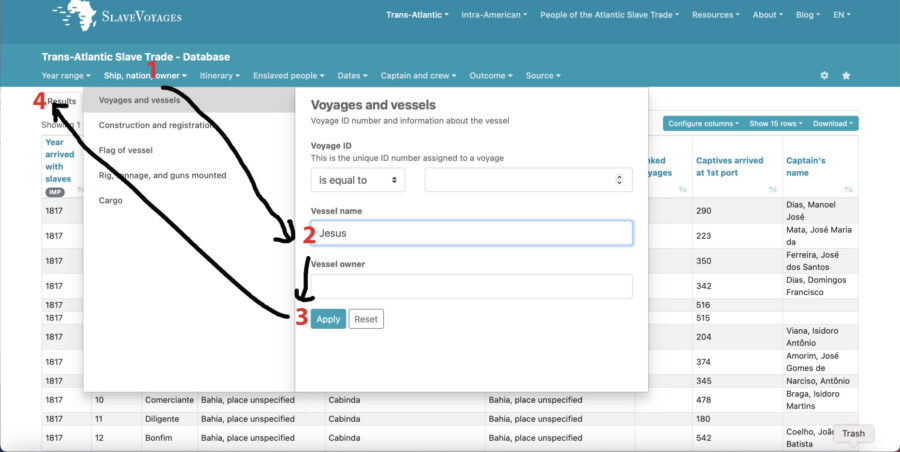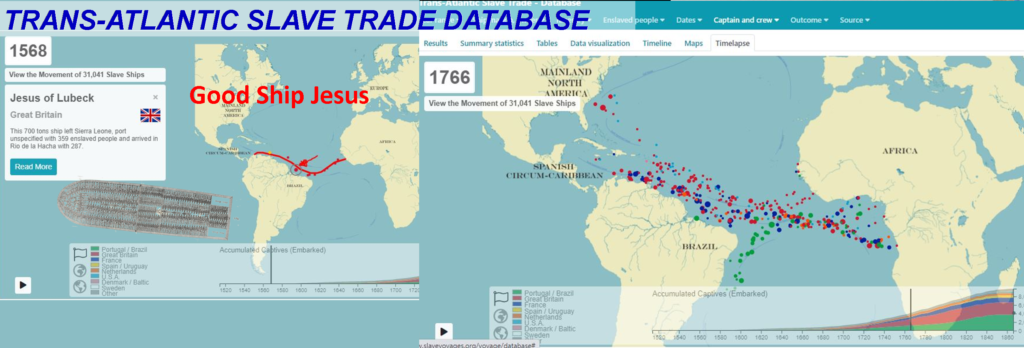WORLD MESSAGE | RISE ORIGINAL MAN!
RISE ORIGINAL MAN ‘DIVINE CIVILIZATION‘
Powerful Spiritual messages that Spirit and the Ancestors have given me to deliver to the Diaspora and those on the Continent.


PEOPLE OF THE ATLANTA SLAVE TRADE – DATABASE
OVERALL PURPOSE | TRANS-ATLANTIC SLAVE TRADE:
To show the detailed Movement of 31,041 Slave Ships in the timelapse of the Slave-trade Commerce
INTRA-AMERICAN SLAVE TRADE:
To show the detailed Movement of 25,784 Slave Ships in the timelapse of the Slave-trade Commerce
Official Information from Website:
This timelapse offers an overall preview as well as demonstration of how the slave movement happened. The results of any user query will display in this timelapse feature. Also, please note the following:
Voyage Size
Each circle on this timelapse represents a single voyage and is both sized, according to the number of captives on board, and colored, according to the three icons at the bottom left of the graph.
Voyage Nationality
Each circle is color coded and the color code represents the nationality of the slave vessel, but users can instead choose Region of Embarkation, or Region of Disembarkation by clicking on the icons to the left of the graph.
Voyage Details
To inspect details of an individual voyage, pause and click on a circle.
Search menu: Search by Year, Ship, Itinerary, etc. Next, click apply. Then, click results.

FYI: Ship name: Jesus of Lubeck aka Good Ship Jesus
TRANSATLANTIC SLAVE TRADE DATABASE – 478 Slave Ships’ name includes Jesus
| 1565 | 98839 | Jesus of Lubeck | Plymouth | Africa, port unspecified | Spanish Circum-Caribbean,unspecified | 92 | Hawkins, John | |
| 1568 | 98851 | Jesus of Lubeck | Plymouth | Sierra Leone, port unspecified | Rio de la Hacha | Hawkins, John |
INTRA-AMERICAN SLAVE TRADE DATABASE – 85 Slave Ships’ name includes Jesus
| Buen Jesus | 1623 | 160721 | Brazil, place unspecified | Buenos Aires | 12 | ||
| Buen Jesus | 1634 | 160743 | Rio de Janeiro | Buenos Aires | 20 | ||
| Jesus, Maria y Joseph | 1669 | 160776 | Brazil, place unspecified | Buenos Aires | Brun, Juan Tomas |
Jesus of Lübeck: How Africans Were Lured into England’s First Slave Ship
John Hawkins urged the Africans to enter his ship “Jesus of Lubeck,” also known as “The Good Ship Jesus.” for salvation, those who entered soon found they were barred from disembarking. Full Article
Jesus of Lübeck was a sailing vessel built in the City of Lübeck in the early 16th century. Around 1540 the ship, which had mostly been used for representative purposes, was acquired by Henry VIII, King of England, to augment his fleet.
The ship which saw action during the French invasion of the Isle of Wight in 1545 was later chartered to John Hawkins in 1562 by Queen Elizabeth I after it foundered during a Battle.
Jesus of Lübeck became involved in the Atlantic slave trade and smuggling under John Hawkins. He successfully organized four voyages to West Africa and the West Indies between 1562 and 1568.
Early in his career, he led an expedition in which he violently captured 300 black Africans in Sierra Leone and sold them to Spanish plantations in the Americas.
An account holds that Hawkins who claimed to be a devout Christian and missionary found the Sierra Leoneans harvesting their crops.
He then proceeded to tell the natives of a God named Jesus and of heaven and hell, afterwards he asked those among them who sought to have Jesus as their saviour to enter his ship “Jesus of Lubeck,” also known as “The Good Ship Jesus.”
His missions were so lucrative that Queen Elizabeth I sponsored his subsequent journeys and provided ships, supplies and guns. She also gave him a unique coat of arms bearing a bound slave.

ENGLAND’S FIRST SLAVE TRADER
John Hawkins was England’s first slave trader. In 1562 he sailed from The Barbican in Plymouth with three ships and violently kidnapped about 400 Africans in Guinea, later trading them in the West Indies.
Full Article
Between 1562 and 1567 Hawkins and his cousin Francis Drake made three voyages to Guinea and Sierra Leone and enslaved between 1,200 and 1,400 Africans.
According to slavers’ accounts of the time this would probably have involved the death of three times that number.
The pattern was consistent. Hawkins sailed for the west coast of Africa and, sometimes with the help of other African natives, kidnapped villagers.
He would then cross the Atlantic and sell his cargo, or those who survived the voyage, to the Spanish. The slave trade was better business than plantations.


